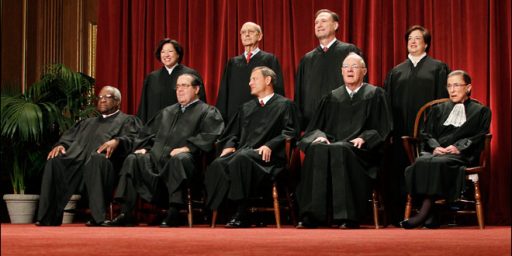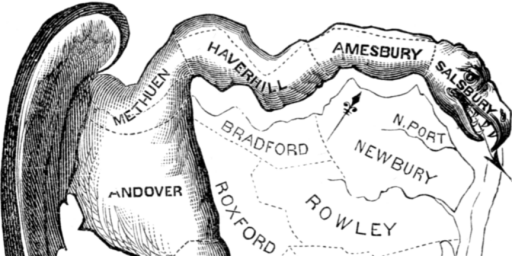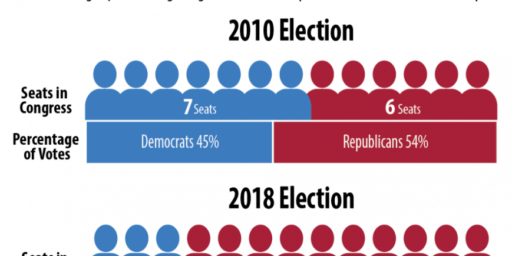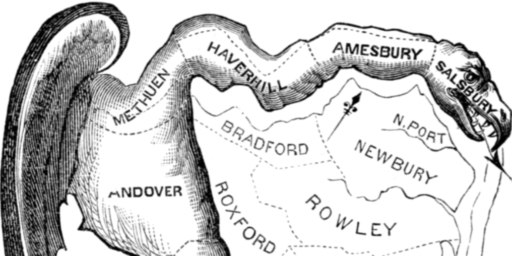A Graph to Ponder
A fundamental flaw illustrated.
It is hard to talk about our system as being the result of electoral competition when there is so little actual electoral competition.
(BTW: the Cook Report (the source of the above) now has the number of toss-ups at 22).
I would (again) suggest that everyone note that the most significant, if not the most significant, variable in determining control of the House in November will not be because one party convinced voters it was the best one to govern, but instead because enough courts around the country forced states to redraw lines.
See Ballotpedia: States conducting redistricting before 2024 elections due to court rulings or legal requirements.
A key flaw in our system of governance is that lines matter more than voters. Further, this structure makes primaries more important than general elections.





23 competitive seats out of 435 is just a smidge over 5%. That’s even lower than I’d have guessed.
@steven or @james, can you point us to any federal office holders or prominent advocacy groups who are fighting for a national level shift to multi-member districts or other approaches to proportional representation? As reassuring as it is to read OTB for this insight into the real problems in our election systems, I would like to provide financial support to those who might try to fix them.
This is an excellent post on how our political structure produces the antidemocratic dysfunction we see around us. But. I always have the question, “Why now?” Except for that one major exception in the 1860s our system has more or less functioned. This chart shows not only that we have only 23 competitive House seats, but that 26 years ago we had 164. What changed? IMHO, money.
A day or two ago someone linked to a Texas Monthly piece on Tim Dunn, the TX billionaire and holy roller who’s largely responsible for what TX politics has become. I commented that Dunn in TX was a microcosm of what’s happening nationally. Serendipity. This morning Jamelle Bouie links to the same Texas Monthly piece,
Political Scientists Hacker and Pierson note that big money corporate involvement in politics started in the mid 70s in opposition to the EPA and OSHA. In 1980 David Koch ran for veep on the Libertarian ticket. He ran because it allowed his family to pour unlimited money into the campaign. Their 1% of the vote, while a record at the time for the Libertarians, convinced he and his brother Chuckles that to get what they wanted politically they’d have to forget votes and just buy it. This decision led to astroturfing the Federalist Society into existence with a primary mission of opening politics up to their money. They’ve been very successful.
It’s not the year 1998 was a great year when no one was polarized.
I think Bush not winning a big victory on election night in 2000 was a shock that Republicans built into their assessments about politics after that. They went from believing that the silent majority was on their side to hoping to eke out a victory in the EC in a matter of days. And everything they have done since has been with the idea that they can’t, overall, compete.
@gVOR10: Money is a variable.
But let’s not forget that population growth, without a commensurate increase in the size of the House, is a huge variable, which also impacts the EC.
Also, as I have written about before, the fact that from the 1860s until the early 1990s, the Democratic Party was a large coalition that encompassed vast geographical and ideological interests is huge. This has resulted in all of the negatives of strict bipartisan being amplified within all of a constitutional order that has lots of veto points.
These are all long-term structural issues that have had long-term consequences to our politics.
To wit:
@James Joyner: I knew it was low, but was surprised when I saw Lee’s graph.
@Scott F.: I can think of no politicians. Advocacy groups off the top of my head: Fairvote, Protect Democracy, and Drutman’s Fix Our House.
@Modulo Myself:
To my point above, 1998 was only 4 years after the “Republican Revolution” of 1994 and the party system was still in transition from the pre-94 system the post-94 system. Look at my posts above and note the clear changes in patterns of Congressional control and also note that the parties at the state level, specifically in the South really change from 1994 to the 2010s. The late 90 and early 00s were a period of significant shifts.
Joe Manchin, for example (a D who can consistently win a deeply red state) is one of the last dinosaurs of that era.
The national narrative and the public consciousness really does not take into account how much partisan realignment took place in the time period I have noted.
Put another way: it isn’t like the South got radically more conservative starting in 1994. Rather, all the conservatives started voting for Rs around that time, when they had, decades earlier, been voting mostly D (except for president).
This has changed party dynamics–and, of course, the overall story is more complex than I have conveyed in a few comment boxes, or even in my longer posts (but there is a lot of data in those posts).
So in lieu of parties trying to persuade people to vote for them, perhaps they should be concentrating on physically relocating their voters from extremely safe districts into ones they could potentially make competitive. Would that cost less?
@Steven L. Taylor:
The national narrative and the public consciousness really does not take into account how much partisan realignment took place in the time period I have noted.
My point was that it came at a time of defeat, both culturally and politically, for Republicans. Bush was a total catastrophe and that fact is what public consciousness does not take into account, in the same way that people just believed that Iraq was being 9/11 or that we found WMDs.
The Iraq invasion/occupation, tax cuts, climate change scepticism, deregulation, the 2008 financial crisis, gay marriage opposition–you can’t separate the catastrophe from the way parties were realigned. Everything they believed in blew up and instead of figuring out why they decided that the explosion never happened.
I can’t imagine how Bush would not have been a catastrophe. It was baked into his character. But it does seem like that set the stage for closing down everything into two hostile camps which can’t even agree if blondes dating football players is American or woke.
One of the main reasons districts have become less competitive is the stratification of country due to contests becoming more nationalised. One can hardly expect a rural dweller support a candidate with urban proclivities and vise versa. Of course there are others factors at play such as scientific gerrymandering and social media. The current system is but another flaw of the US Constitution.
@Raoul:
FOX/GOP has been very successful in creating a cultural divide between urban and rural, or college and not. Otherwise I don’t see any fundamental reason country people wouldn’t support, say, Ukraine funding, or a bipartisan border bill.
@Modulo Myself:
It’s both. Wokeness is now as American as apple pie, or will be soon.
This and other liberalizing social changes have sent outdated, regressive forces into spasms of bewildered, impotent rage.
@Steven L. Taylor: It seemed to me that the shift you described occurred much earlier than 1998. I would put the shift to the 1960’s when LBJ was able to push through the civil rights and voting rights acts. These acts, as LBJ predicted, caused the old Confederate States which had previously been solidly Democratic to shift to Republican. LBJ was wrong in predicting the loss would only be for a generation. The other big shift in that time period was in the military, especially the officer corps, which had in the past been largely nonpolitical. I was serving as an officer in the Marine Corps at the time and can attest to the universally held disgust for LBJ’s conduct of the war. That shift in the military to the Republican party holds to this day although it has weakened somewhat as the result of the wars in Asia.
@a country lawyer: I spilled a lot of pixels in those links, which include, IIRC, talking about the cracks in that party system starting in the 1960s (to include John Tower, a Republican, winning LBJ’s seat in the Senate when he became Veep.
I am not suggesting that the change was the flipping of a switch, but I am quite confident in pointing out 1994 as a clear inflection point. The 1932-1994 party system is simply not the 1994-2024 party system (although one can find some overlap).
Go look at the posts I linked for a more complete run-down.
@a country lawyer:
Also, based on some of what I have been reading, the shift was also underway prior to LBJ too. It had started as early as the 1920s and then may have been slowed down because of the depression and then the second world war.
@Steven L. Taylor: Hi Scott, I work with Lee at Fix Our House — feel free to reach out if you would like to discuss the work we’re doing: du****@fi*********.org.
Also, you can read more about this graph in Lee’s recent substack post. FWIW, there’s a small error in the above chart — the real number of competitive districts according to Cook is closer to 10% (though it’s all just an estimate at this point, and that’s still way too small, and it still means that the courts may effectively determine control of the House.) The corrected chart is in this post: https://leedrutman.substack.com/p/the-2024-house-elections-present